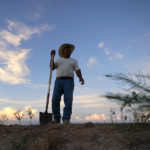Stressed Colorado River keeps California desert farms alive
Sep 13, 2022, 7:00 AM | Updated: 9:05 am

Water flows along the All-American Canal Saturday, Aug. 13, 2022, near Winterhaven, Calif. The canal conveys water from the Colorado River into the Imperial Valley. (AP Photo/Gregory Bull)
(AP Photo/Gregory Bull)
SACRAMENTO, Calif. (AP) — When Don Cox was looking for a reliable place to build a family farm in the 1950s, he settled on California’s Imperial Valley.
The desert region had high priority water rights, meaning its access to water was hard for anyone to take away.
“He had it on his mind that water rights were very, very important,” said his grandson, Thomas Cox, who now farms in the Valley.
He was right. Today the Imperial Valley, which provides many of the nation’s winter vegetables and cattle feed, has one of the strongest grips on water from the Colorado River, a critical but over-tapped supply for farms and cities across the West. In times of shortage, Arizona and Nevada must cut first.
But even California, the nation’s most populous state with 39 million people, may be forced to give something up in the coming years as hotter and drier weather causes the river’s main reservoirs to fall to dangerously low levels. If the river were to become unusable, Southern California would lose a third of its water supply and vast swaths of farmland in the state’s southeastern desert would go unplanted.
“Without it, the Imperial Valley shuts down,” said JB Hamby, a board member for the Imperial Irrigation District, which holds rights to the largest share of Colorado River water.
EDITOR’S NOTE: This is part of a collaborative series on the Colorado River as the 100th anniversary of the historic Colorado River Compact approaches. The Associated Press, The Colorado Sun, The Albuquerque Journal, The Salt Lake Tribune, The Arizona Daily Star and The Nevada Independent are working together to explore the pressures on the river in 2022.
A century ago, California and six other states — Arizona, Colorado, Nevada, New Mexico, Utah and Wyoming — created a compact that split the water into two basins and set rules for how much water each would get. A series of deals, laws and court cases that followed led California to get the most water and made it the last to lose in times of shortage.
Fear and frustration over California’s use of the river has driven the compact since its early days. In western water law, the first person who taps the source gets the highest right, and California cities and farmers have relied on the river for more than a century.
Other western states worried California would lay claim to all the river’s water before their own populations grew. The compact and the series of deals that followed attempted to find a balance to protect California’s supply while ensuring other states got some too. California, meanwhile, benefitted when the federal government began building the Hoover Dam to help control the river’s flow.
Today, the states are now gearing up for a 2026 deadline to renegotiate some of the terms to better deal with drought and protect two major reservoirs, Lake Powell and Lake Mead. But before that, the U.S. Bureau of Reclamation has demanded the states find a way to cut their use by roughly 15% to 30% to stave off a crisis. The states failed to meet a mid-August deadline to reach a deal, but negotiations are continuing and no new date for an agreement has been set.
All eyes are on California and its major water rights holders — namely the Imperial Irrigation District and Metropolitan Water District of Southern California — to see if they will give up some of their share. Both districts say they’re willing to use less water or pay others to do so — especially if cooperating means they can avoid challenges to their senior rights.
But they’re playing coy about what exactly they’re willing to give.
The river is the only water supply for the Imperial Irrigation District, whose farmers grow broccoli, onions, carrots and other winter vegetables as well as alfalfa and other feedstock. The limited water underneath the ground in the region, near California’s border with Arizona and Mexico, is not usable, and it does not have access to state water supplies.
The irrigation district was historically entitled to more water than either Arizona or Nevada, though it’s given some up over the years in exchange for payment from cities like San Diego and Los Angeles. In 2019, its board rejected a drought contingency plan signed by other water users in Arizona, Nevada and California.
This time around, officials say the district would be open to leaving fields unplanted to save water on a temporary, emergency basis. But neither Hamby nor board spokespeople would say how much.
State officials are looking to the $4 billion approved by Congress for the Colorado River as a possible source of money that could be used to pay the district and, in turn, farmers, to use less water.
The farmers aren’t privy to all of the district’s negotiating tactics, but are trying to organize among themselves to avoid having cuts foisted on them, Cox said. Many farmers have already installed drip irrigation lines that use less water, but they would be willing to adopt more conservation tactics if they’d be paid to do so.
Already, Cox said he’s making decisions about whether to plant on all of his vegetable fields this fall because he’s getting less water than normal under a new system adopted by the board.
“With water uncertainty, there’s going to be more uncertainty on food supply,” he said.
And it’s not just farmers who rely on the Imperial Irrigation District’s water. Runoff from the farms feeds the Salton Sea, a massive inland lake created in the early 1900s when the Colorado River flooded. It’s now rapidly drying up, exposing surrounding communities to toxic dust and killing the habitat that birds and fish rely on. The state and federal government are now looking for other ways to support the sea in the absence of river water, and its being eyed as a possible site for lithium extraction.
“We’re talking about a body of water surrounded by communities who have been marginalized for so (long), that don’t have the infrastructure or capacity to protect themselves from climate change, from less availability of water, from more dust,” said Silvia Paz, executive director for Alianza Coachella Valley, an organization fighting to improve the economy and health outcomes in the region.
Behind the irrigation district, the Metropolitan Water District is the state’s second largest user of the river’s water. The Colorado makes up about one-third of the water supply the district uses to provide water for drinking, bathing, landscaping and recreating to roughly half the state’s population. Los Angeles County, the nation’s largest, is one of the many areas in Southern California that relies on the river’s water.
It’s allowed to store some of the water it doesn’t use in Lake Mead, which California officials say has actually helped stave off a river crisis in recent years. But this year, short on other supplies, the district may actually try to pull some of that water out if needed, a move that would likely cause friction with other states in the basin.
The district also gets water from the Sacramento-San Joaquin River Delta, the state’s main source of water supplies. But the Delta is suffering from drought, too, and the state only approved 5% of requested supplies this year. As it looks to stabilize its water supply for the future, the district is spending billions on a water recycling plant and urging people to use less water for their lawns.
Still, ensuring the Colorado River is available in dry years when other supplies aren’t available is the district’s priority, said Bill Hasencamp, the district’s Colorado River manager.
Farm-heavy water districts in the Coachella Valley and Riverside County also get Colorado River water, which they use for crops like citrus, melons and barley. The Fort Mojave Indian Reservation and Colorado River Indian Reservation are among the tribes in California with river rights.
Looking to the future, both climate change and politics are at play as California’s water users debate what it will take to keep the river alive.
“What they really want is reliability and predictability,” said Michael Cohen, a Colorado River expert with the Pacific Institute. “What they don’t want is Arizona screaming that Phoenix and Tucson are dried up and California doesn’t take a drop of reductions.”
___
The Associated Press receives support from the Walton Family Foundation for coverage of water and environmental policy. The AP is solely responsible for all content. For all of AP’s environmental coverage, visit https://apnews.com/hub/climate-and-environment
Copyright © The Associated Press. All rights reserved. This material may not be published, broadcast, rewritten or redistributed.




















